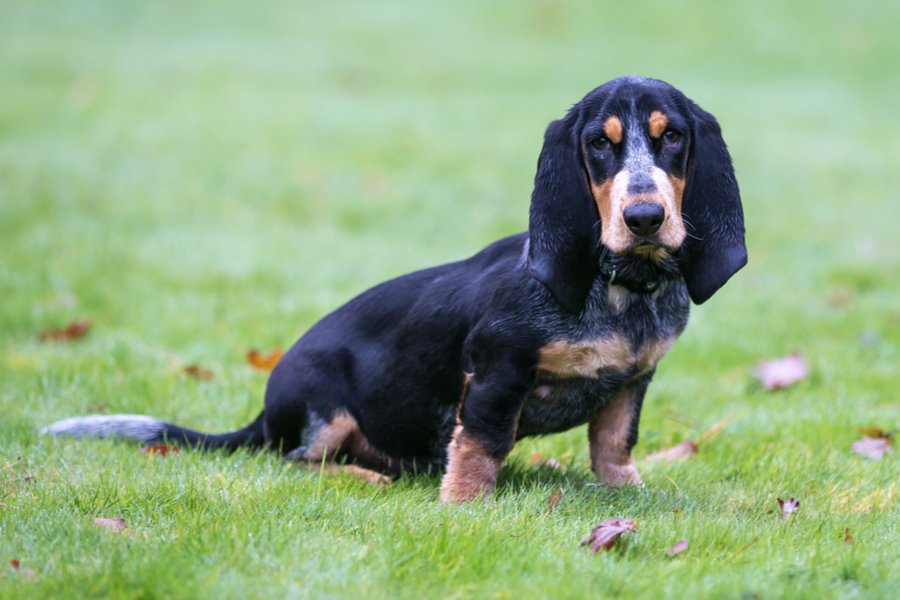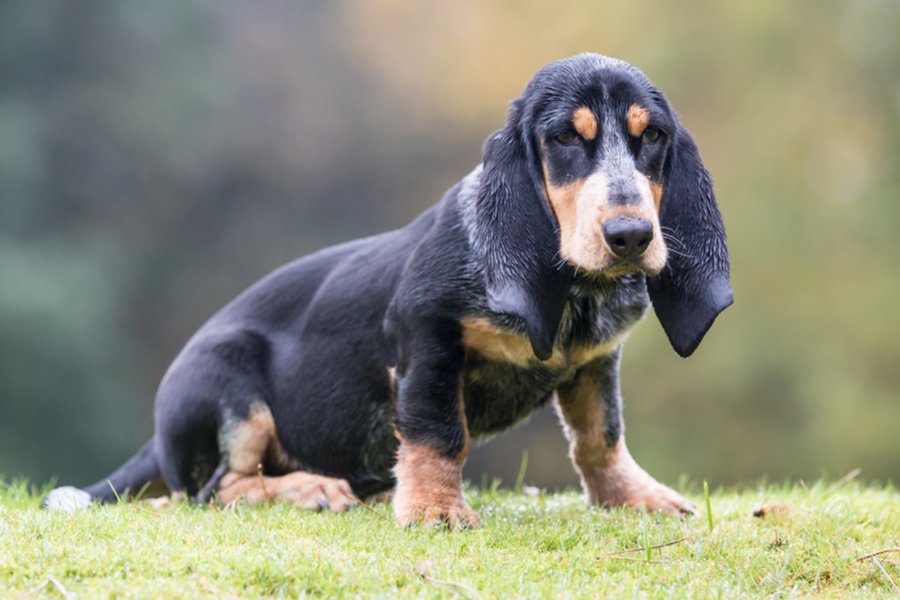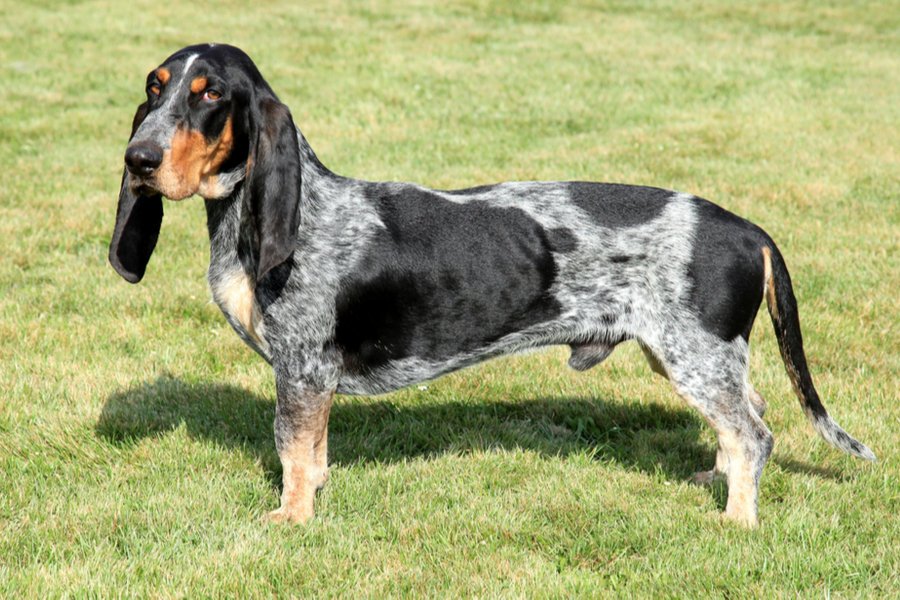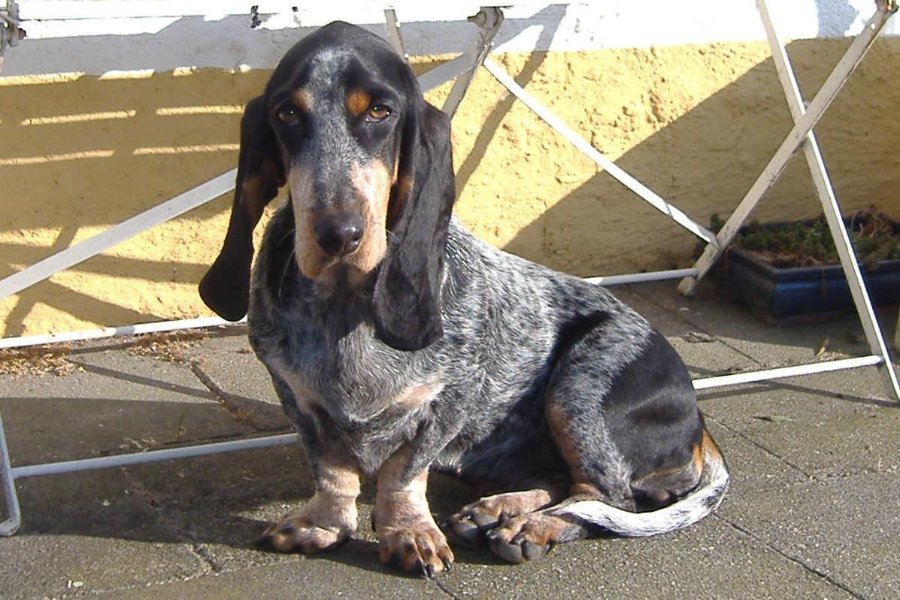Average sizes and life expectancy for this breed:
A hound native to France, the Basset Bleu de Gascogne is among the lesser-known French hounds in the United Kingdom because they were only recently introduced to England. These charming hounds were first bred in the Gascony region of France, where they got their name. The Basset Bleu de Gascogne was initially bred to work, but today, they make excellent family pets and affectionate, loyal canine companions.
While they are frequently confused with their cousin, the Basset Hound, the Basset Bleu de Gascogne is rare. In fact, there are only a handful of dogs registered by the Kennel Club. These charming dogs are a slow-and-steady type of hunting dog so hunters can keep up with them on foot. The Basset Bleu de Gascogne has a strong prey drive and a remarkable sense of smell that can track scent trails several days old.
The Basset Bleu as a working dog is generally kept in packs. As a result, they are very sociable and easy-going. These dogs develop deep bonds with their human companions and make good-natured pets for people of all ages. Even though the Basset Bleu de Gascogne is not built for speed, they still require a good deal of exercise. So, they make ideal hiking or walking companions.
In the 1990s, the Basset Bleu de Gascogne was recognised as a breed by the Kennel Club. While this dog breed is very popular in France, they are not currently in demand in the United Kingdom.
See available puppies




Originating from the Gascony region of Southwestern France, the Basset Bleu de Gascogne is a very old breed that dates back to the 14th century. This dog breed is thought to have been descended from the Grand Bleu de Gascogne, a taller dog from the same region. However, it is unclear whether the breed was developed through selective breeding using short-legged dogs, or whether the Grand Bleu was crossbred with more vertically challenged Basset Saintongeois.
The Basset Bleu de Gascogne was further refined during the French Revolution. Breeders wanted a dog that was fast enough to keep up with horses but also slow enough to allow hunters to keep up with them.
After the Revolution, the popularity of the Basset Bleu soared. However, during the late 19th century, it nearly became extinct. The breed was saved by Monsieur Alain Bourbon who managed to create a sustainable population of the Basset Bleu de Gascogne by crossing the remaining dogs with both Basset Saintongeois and Grand Bleu de Gascogne’s.
Today, the Basset Bleu de Gascogne has a stable population in their homeland, however, they remain uncommon across the globe. This breed was recognised by the United Kennel Club in 1991, but the American Kennel Club has not yet granted their full recognition.


The Basset Bleu de Gascogne is often confused with the Basset Hound because of their short legs, long body, and fairly large heads. The only thing that sets them apart is their distinct black and white mottled coat.
Their wedge-shaped heads are domed with a well-defined occipital point at the back of their heads. These dogs have large black noses with wide-opened nostrils from their scent hound heritage.
Their oval-shaped eyes are dark brown and have a gentle yet sad expression to them, which adds to their endearing appearance. Their ears are set low and fine to touch. They curl slightly inwards and extend just beyond the tip of the nose when pulled forwards.
Basset Bleu de Gascogne’s have strong jaws with a perfect scissor bite. Their long necks are slightly arched with a slight dewlap around their throats. Their straight front legs are well-boned. However, some dogs may have slightly crooked legs which are accepted under the breed standard. Their shoulders are well-muscled and well-laid-back without being heavy.
These dogs have long bodies and deep chests that extend to their elbow and show their prominent sternum. They also have well-rounded ribs, and their back is long, strong, and level. Their strong loins are short and slightly arched. Their bellies can have a slight tuck up which adds to their athletic-looking body. A Basset Bleu’s back legs are well-muscled and strong. Their oval-shaped feet are strong with black pads and nails. Their tails are set high and carried gaily in the shape of a sickle when they are excited or alert, but when they are relaxed it is carried lower. Their tail is at its broadest at the base then it tapers to the tip.
The Basset Blue de Gascogne’s coat is short and dense. Accepted coat colours are black on a white base, covered entirely with black mottling and ticking that produces a blue appearance. They have two black marks on their heads that cover both of their ears and encompass their eyes before ending at their cheeks. Above each eye, these dogs have a tan spot that gives them the appearance of having four eyes. Their cheeks also have these tan marks, as well as their flews, on their ears, on their legs, and under their tail.
Known to be laidback in a home environment, the Basset Bleu de Gascogne loves to play games like fetch with their beloved companions and curl up at the end of a long day. These charming dogs make an excellent choice for those who live more sedentary lives and have large secure gardens so they can roam around whenever they please.
The Basset Bleu de Gascogne are affectionate and loyal hounds that form strong bonds with their families. They are also known to be gentle, which is why they make such excellent family pets. Moreover, they have a natural affinity with kids and adore being around them.
These loyal dogs are intelligent too. But because of their hound nature, they tend to be a bit stubborn, which can be challenging when you are training them. So, training and socialisation from an early age are essential for them to grow into well-balanced, well-rounded, and obedient dogs. Introduce them to as many people, new situations, other dogs, and animals as possible so they become confident and outgoing dogs.
Basset Bleu de Gascogne dogs are sociable and playful. They get along well with virtually everybody. They don’t make the best guard dogs, but they will bark in a sing-song way if they need to or feel threatened.
These gentle dogs also exhibit independence – they decide on their own whether they have had enough. Also, because of their high prey drive, they can’t be fully trusted with smaller pets and in open outdoor spaces as they can have sudden urges to pursue a scent trail.


Because of their independent nature and strong hunting instincts, the Basset Bleu de Gascogne can be challenging to train. These dogs have sensitive ears and noses, which can easily cause them to become distracted. Run short training sessions that are fun and engaging to ensure your dog remains focused.
Persistence and a lot of patience are needed to train a Basset Bleu. So, if you are looking to bring home this dog, you need to have the knowledge to properly train and socialise them. Reward-based training is the best way forward with this breed. Also, remember to keep them on a lead when outdoors until fully trained.
The Basset Bleu’s coat is short and hard-wearing. So, it doesn’t need much brushing. Weekly brushing is sufficient to keep their coats healthy. However, they may require brushing 2-3 times a week during the heavy shedding periods in Spring and Autumn. It is worth noting that this dog breed produces a lot of skin oils, making them pretty smelly. With this said, they need regular washing. It is recommended that you use antifungal shampoos to help control their odour by keeping the skin-dwelling yeast under control. Make sure to ask your vet how to use this because it is a prescription-only product.
Frequently check their ears for debris, dirt, and wax buildup. Clean their ears by using a damp cotton ball with an ear cleanser recommended by your veterinarian. Never use cotton swabs inside their ear canals as this can damage them. If you notice any foul smell, swelling, soreness, inflammation, or they incessantly shake or scratch their head and ears, talk about this with your vet for a checkup, as this may be an indication of an infection.
Daily dental hygiene is still best to prevent tooth and gum diseases and bad breath. But twice weekly brushing is sufficient to get rid of any tartar and bacteria buildup. Ask for a recommendation from your vet on which dental products work best to efficiently clean their teeth, tongue, gums, and mouth.
Trim their nails once or twice a month (or as needed) to keep them clean and neat. Make sure you do this frequently to prevent very long nails as these can be uncomfortable for your Basset Bleu. While you trim their nails, examine their paw pads to check they are injury-free and healthy.
Furthermore, regularly examine their body as you groom them for any rashes, wounds, inflammations, and other indicators that they may have an infection. Their eyes must be healthy, clear, and clean without soreness or discharge.


A Basset Bleu de Gascogne’s average life expectancy is 12-13 years, given that they are appropriately cared for, and provided with a high-quality and nutritious diet that matches their age and needs. Make sure you purchase puppies from a well-established, licensed breeder because they will be able to perform DNA tests to check for any underlying health conditions.
These dogs are known to be a healthy and strong breed. However, the Basset Bleu can have some of the health conditions stated below:
The Basset Bleu de Gascogne is a highly prized hunting dog in their native country, France. However, these charming dogs also make excellent family pets. They have a natural affinity with kids and love being in a family environment. While they love being with children, it is still advisable to supervise any interaction between a Basset Bleu and a child to avoid any mishaps
The Basset Bleu de Gascogne generally gets on well with other dogs, especially when socialised from a young age. However, extra care should be taken when these dogs are around small animals because of their high prey drives.


We can connect you with Breeders that are specialized in this particular breed.
See available puppies

Need some advice?
Whether you're a first time pet owner, an experienced pet owner, a new or long-time breeder, or just curious about pets, we've got you covered!

January 17, 2024
What Is The Personality Of Russian Blue Cats?
Russian Blue cats are most known for their distinctive shimmery blue-silver coat and piercing green eyes. However, this breed’s calm and gentle temperament is what makes them shine the most in the feline world.

January 17, 2024
10 Facts About Russian Blue Cat Breed
Russian Blues are one of the most aesthetically stunning cat breeds, with a gorgeous plush silvery coat and vibrant green eyes. However, it’s not only their appearance that is beautiful; their nature is too.

January 17, 2024
How To Choose The Right Cat Breed for You
Cats can make the most fantastic animal companions; they are adorable, friendly, and loving. However, not all felines are created equal. There are many different breeds, of which each has its unique personality traits.
Need some help?
Contact us to speak to our friendly advisor, who will gladly help you find your dream pet!



We are registered in England and Wales under registration number 12568840,
and our registered office is at 58-60 Kensington Church Street, W8 4DB London, England.
© 2023 The Pedigree Paws